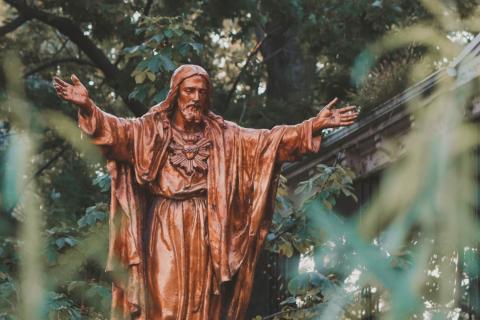
The following text is drawn from "The Integration of Intellectual and Moral Education in the University," found in Renewal of Catholic Higher Education: Essays in Catholic Studies in Honor of Don J. Briel, published in 2017 by University of Mary Press. It serves as the first of a two-part series.
The modern university has abandoned any moral authority to shape the souls of its students. This is true first on the grounds of the separation of intellect and will: After all, what has scientific study or academic excellence to do with what you do in your home or your dorm room? Second, on the grounds of freedom from coercion: What right does a university have to tell its students what to believe or to shape their moral convictions? On most college campuses, educators and administrators demonstrate a genuine anxiety that they not be perceived as imposing a morality. This reluctance has made “formation,” at one time a respectable word for an important dimension of education, a negative term. The contemporary situation is summarized well by Harry Lewis, professor and onetime dean of Harvard: “Harvard teaches students but does not make them wise.”1
While at many Catholic institutions of higher education the idea of moral education has not been abandoned, it has nevertheless been severely marginalized. This should give us pause given the Catholic commitment to an integrated view of the human person that understands education to be at the same time moral and intellectual. John Henry Newman put this well in his 1856 sermon, “Intellect, the Instrument of Religious Training,” insisting at once on both the intellectual and “religious” formation of university students:
Catholic Studies should be understood as one promising way that Catholic higher education can “reunite what man has divided” in respect to the intellectual and moral aspects of education.
The purpose of this essay is twofold: first, to offer a brief historical account of the gradual separation of moral and intellectual education in Catholic higher education and draw a few lessons from this history; and second, to offer some practical recommendations for the way forward, based both on the history of higher education and my own experience with Catholic Studies and other endeavors sharing a family likeness. Throughout, I hope at least to suggest something of a rationale for Catholic Studies as a “more-than-academic” program and to set forth some initiatives that might be fruitfully supported or sponsored by Catholic Studies programs. The integrative approach of Catholic Studies to education includes by necessity initiatives and programming that seek to assist students and faculty to reunify their intellectual and moral lives. Because of this, Catholic Studies should be understood as one promising way that Catholic higher education can “reunite what man has divided” in respect to the intellectual and moral aspects of education. This integration requires something like Catholic Studies on our Catholic campuses in the post-Christian world in which we live.3
A Brief Historical Account of the Separation of Moral and Intellectual Formation in Higher Education
When Newman criticized the separation of religion and science in higher education, he was combating what he believed was already a widely held view. In fact, Newman was speaking into a larger, and, by 1856, decades-old debate over the reform of higher education in England. There was disagreement at the most fundamental level as to the nature and purpose of higher education. Was the purpose of higher education to form professional researchers whose mission was to advance the seas of knowledge? Or was the purpose to educate, both intellectually and morally, future leaders of England? Is a university education for the accumulation of knowledge or for instilling a habit of mind?
One attempt to unite these two ends is particularly relevant in this context. Some argued that research in itself was a moral education. Research, after all, requires a great deal of discipline and a dedication to scientific truth, and therefore it trains students in perseverance and increases their love for truth. Newman’s response to Robert Peel’s version of this argument produced—in the judgment of his biographer Ian Ker—perhaps his best piece of polemical writing. Newman concludes his pamphlet on The Tamworth Reading Room in this way:
In his Dying of the Light, Burtchaell describes an exchange between the then presidents of Boston College and Harvard over the merits of the elective system of education for undergraduates. Boston College, founded by the Jesuits in 1863, was, at the time of this exchange, still located rather conspicuously directly across the Charles River from Harvard University. Harvard professors and indeed presidents took a certain delight in berating what they perceived as their intellectual and moral inferior across the river. In the words of one Harvard professor: “To those who, like ourselves, look upon the Romish system as a system of dangerous and fatal error, as a monstrous incubus, stifling and oppressing the Gospel of Christ, no place can be so dangerous to the young as the Jesuit college, every exercise of which is made to assume a religious aspect, and to exert a religious influence.”5 For Harvard president Charles Norton Eliot, the problem with religious education was its undue authoritarianism. In The Atlantic Monthly, Eliot deplored any “system of education that treated certain subjects as obligatory” and went so far as to equate Muslim and Catholic education. He noted with derision that Jesuits had hardly changed their educational system in 400 years.
In his response, which The Atlantic Monthly refused to print, then president of Boston College Timothy Brosnahan, SJ, first corrected Eliot on a factual matter: The Ratio Studiorum was only 300 years old, not 400. He then argued that “if the Jesuits were out of date, it was not by 400 years or 300, but by 15, for it was only that long since President Eliot had persuaded his colleagues that studies must be entirely elective.”6 President Brosnahan then identified the real weakness in an entirely elective system: namely that the student, without the proper knowledge of self or moral truth, has to determine his own course of studies at the outset of his education. In Brosnahan’s words,
In 1955 John Tracy Ellis published his influential essay “American Catholics and the Intellectual Life.” This critique of the then-reigning mode of Catholic higher education by the leading Catholic intellectual in the United States launched an enduring conversation among Catholics about the limitations of their own system of education. The critique was codified by Thomas O’Dea in his 1958 book, The American Catholic Dilemma.10 O’Dea identified four basic characteristics of the American Catholic milieu that inhibited the development of mature intellectual activity:
- Formalism: the tendency to view the world in general as already grasped and conceptually classified. This was an attack on the version of Scholasticism then predominant in Catholic colleges.
- Authoritarianism: According to this critique, the Church’s teaching authority, the Magisterium, was too involved in academic matters.
- Overemphasis on vocations: O’Dea argued that too many Catholics were worried about religious and priestly life and not, strictly speaking, academic life.
The fourth, the most relevant to our discussion, is moralism. Catholic education, O’Dea claimed, was too concerned with the moral education of its students, hindering the development of true Catholic scholars. He claimed that Catholics viewed the world not as filled with intellectual challenges, but with spiritual perils. The Catholic mentality, he wrote, is basically “neo-Jansenism grafted onto a lower-middle class mentality.” In conclusion, as historian Phil Gleason puts it, “The overall impression conveyed by the discussion was that practically everything historically associated with American Catholic life, intellectual and otherwise, would have to be scrapped.”11
The life of universities, from the classroom through the dorm room, will shape a student for good or ill. It means that the choice is not will we or will we not have a university that is morally educative of our students, but rather, will the moral education our students receive be clear and true and rational, or will it be haphazard and arbitrary and dominated by sentiment, fashion and ideology?
These critiques are not entirely absent of reason and merit. That there were not enough homegrown Catholic scholars in the mid-1950s to supply the needs of growing institutions is simply true. And most scholars agree on the limitations of scholastic manualism. Still, as David Solomon has argued, the moral education that students received in these institutions may not have been as ineffective as some have claimed. Whatever the case, Catholic educators were experiencing increasing pressure and incentive to change their approach in a number of matters, including the role of moral education. Also, surrounded by deeply Catholic environments, many could not imagine that such changes in theology or the curriculum or the approach to moral education could ever threaten the Catholic identity of their institutions.
Catholic educators thus faced a choice. They could join with the wider trajectory of higher education in the United States and abandon or diminish the importance of moral education in order to correct their moralism, or, through a process of recovery and development, they could choose to create a wider intellectual culture—free, yet firmly rooted in the truth—that did away with the formulaic and simplistic moralistic approach to education. Ultimately, through a process of abdication, they settled for a considerable compromise. James Burtchaell describes this process:
Given the wider cultural trajectory, this has proved to be a radically insufficient and temporary solution. Today, the deans of students at many Catholic universities are trained much like their peers in non-Catholic institutions and often embody the same view of moral education. The dominant contemporary paradigm for moral education is nicely summarized in a 2007 Report on General Education by Harvard College. The report was the culmination of a process of review that began in 2002. In the words of the report:
Why a Morally Neutral Education Is Problematic
Before turning to some practical recommendations that address this rupture in education, it is important to consider briefly three issues that, together, reveal the fundamental flaw in the current pursuit of “moral neutrality” at modern universities.
First, without asking whether the goal of turning a university into a morally neutral space is a good one, we ought to reflect for a moment on whether it is even possible. There are serious reasons to doubt this. As Newman pointed out in his Idea of a University:
Second, it is important to recognize that at the root of the two different visions of moral education we considered are two different anthropologies. For the authors of the Harvard report, the human being is an autonomous choosing individual, with no inherent end, whose will and intellect are unrelated to one another. Ethical choices are purely a matter of rational argumentation. How you live has no effect on how you think. The best thing one can do for such a being, therefore, is to question assumptions and multiply choices, lest one risk the possibility of coercion. For President Brosnahan, the human being not only has an inherent end, but the pursuit of that end requires a moral education that addresses both will and intellect, because they cannot be separated in action. According to St. Thomas Aquinas: “The will moves the intellect as to the exercise of its act... But as to the determination of the act... the intellect moves the will.”15 It follows that if the will is habituated to choosing evil, it will cloud the intellect. On the other hand, if the intellect is incapable of seeing truth, the will becomes habituated to choosing evil. (And this is not to mention the moral significance of the passions in relation to both intellect and will.) Yes, what you do in your dorm room does affect your moral view of the world, and what you learn in the classroom does affect your choices and actions.
Third, as universities no longer offer a coherent moral view, the serious question raised by Christopher Dawson—among others—comes to the fore. Namely, on what basis will contemporary society organize itself? Today, as Cardinal Ratzinger had asserted in his famous debate with Jürgen Habermas, “the basic question of what is good, and why one should do what is good even where this is to one’s own disadvantage, remains largely unanswered in the public domain.”16 This constitutes a crisis. Without a shared vision of the good, all “freedom... is anarchy and therefore destructive of freedom.”17 Without a shared vision of the good, man becomes the subject, not the master, of his own scientific power. As Ratzinger said further: “Man is now capable of making men... [man] has become a product.”18 One is reminded of C.S. Lewis’ account of the “abolition of Man,” when history reaches a point where some men, the “Conditioners,” guided by nothing more than their own whim, will through scientific power determine what human beings ought to be.19
This is all simply to say that the abandonment of moral education in the university produces consequences that extend beyond its walls. The incoherent state of our moral discourse “after virtue,” combined with a lack of a coherent, integrated education of intellect and will, puts at risk our very ability to function as a free society oriented to a common good: Humanity itself is thus put at great risk.
1 Harry Lewis, Excellence without a Soul: How a Great University Forgot Education (NY: Public Affairs, 2006), 255.
2 John Henry Newman, Sermons Preached on Various Occasions (London: Longmans, 1908), 12-13.
3 John Henry Newman, Discussions and Arguments on Various Subjects (London: Longmans, 1907), 304.
4 The following is taken from James T. Burtchaell, The Dying of the Light: The Disengagement of Colleges and Universities from Their Christian Churches (Grand Rapids: Eerdmans, 1998), 568-72.
5 Ibid., 566.
6 Ibid., 570.
7 Ibid., 571.
8 Ibid., 568. Emphasis added.
9 James Fox cited in Lewis, Excellence, 150.
10 Thomas O’Dea, American Catholic Dilemma (Chicago: University of Chicago Press, 1958).
11 Philip Gleason, Contending with Modernity: Catholic Higher Education in the Twentieth Century (NY: Oxford University Press, 1995), ch. 13.
12 Burtchaell, 821.
13 Stephen M. Kosslyn et al., “Report of the Task Force on General Education,” 2007, 1-2, 6.
14 John Henry Newman, Idea of a University (London: Longmans, 1907), 148.
15 Summa Theologica, I-II, q. 9, a. 1, ad 3 (Fathers of the English Dominican Province translation).
16 Joseph Ratzinger, Values in a Time of Upheaval (San Francisco: Ignatius Press, 2006), 32.
17 Ibid., 33.
18 Ibid., 36.
19 This is, of course, a reference to C.S. Lewis’ Abolition of Man, first published in 1943.

Next: The Reintegration of Intellectual and Moral Education in the University
The reintegration of intellectual knowledge and moral formation is an urgent necessity at Catholic universities if students are to receive the formation they need to navigate life.


